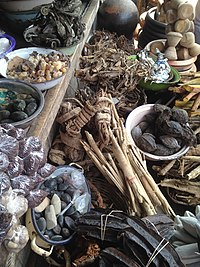
Photo from wikipedia
Introduction Globally, traditional medicine is widely used to treat a variety of injuries and illnesses, including dog bites, and exposures that are risky for rabies. However, efficacy of most traditional… Click to show full abstract
Introduction Globally, traditional medicine is widely used to treat a variety of injuries and illnesses, including dog bites, and exposures that are risky for rabies. However, efficacy of most traditional remedies used for rabies prevention or treatment has not been demonstrated in controlled trials or proven in community-based surveys. Methods Six databases were searched including the terms rabies, traditional treatment, traditional remedy, traditional therapy, traditional medicine, and medicinal treatment to review traditional remedies used in the prevention and treatment of rabies. In addition, published literature of rabies transmission dynamics was used to estimate statistical likelihood of dog bite victims developing rabies to provide clarity as to why traditional healers have a high apparent success rate when preventing death from rabies in victims bitten by suspected rabid dogs. Results Literature review yielded 50 articles, including three controlled experiments, that described use of traditional remedies for rabies prevention and treatment. Traditional remedies for rabies ranged from plant- or animal-based products to spiritual rituals; however, only a few controlled mice trials were conducted, and none of these trials demonstrated efficacy in preventing or treating rabies. Risk of dying from rabies after a bite from a dog with unknown rabies status is low, 1.90% (0.05%-29.60%). Therefore, traditional healers had a 98.10% (70.40%-99.95%) apparent success rate in preventing death from suspected rabid dog bites despite inefficaciousness of herbal remedies. Conclusion There was no universal plant species or route of administration that was consistently used for rabies prevention or treatment across countries. No traditional remedy was efficacious in the prevention or treatment of rabies in randomized controlled experiments. Understanding the cultural context under which traditional remedies are used may facilitate collaboration of traditional healers with the modern medical system to ensure timely and appropriate use of proven therapies for prevention and clinical management of rabies.
Journal Title: PLoS Neglected Tropical Diseases
Year Published: 2022
Link to full text (if available)
Share on Social Media: Sign Up to like & get
recommendations!